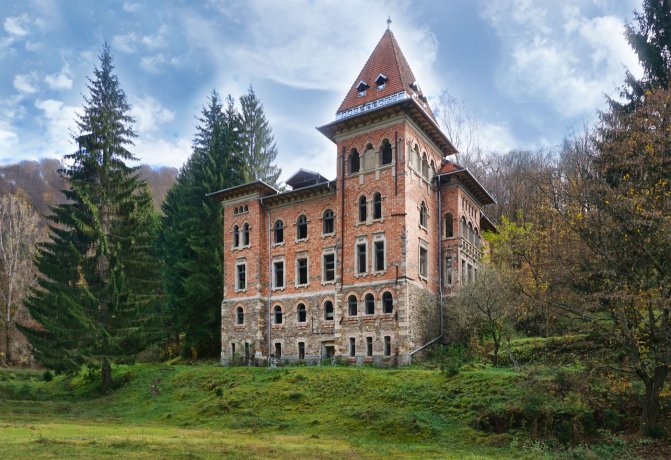>€295k Zlatna, ROMANIA. Historic Castle with Development Potential
Historic Romanian Castle For Sale with Development Potential
This Castle is For Sale with Artmark Historical Estates
Walking along the picturesque road that climbs up through the Apuseni Mountains, from Alba-Iulia towards Arieșeni, you will surely be amazed by the beauty of the places. However, once you passed Zlatna town, at the entrance in Botești, a plain curve will bring to your eyes an unexpected view: a spectacular castle. Nowadays, slightly blurred due to its tumultuous history, however hard to miss: starting with its stunning stature bordering the forest, to the architectural details it still retains.
The castle was built in-between 1936 and 1939 by Ion Gigurtu, the son of Olga Gigurtu (daughter of Nicolae Balcescu's brother and the niece of painter Theodor Aman), former Romanian engineer and pro-German, a right-wing politician. His political career began in 1918 within the People's Party. On the 10th of April 1932, he followed Octavian Goga when he split from PP setting up his own political party, the National Agrarian Party. From the 14th of July, 1935, Gigurtu becomes one of the leaders of the new formation: the National Christian Party, resulting from the merge of PNA and LANC (Professor A. C. Cuza’s party). In July 1937, he was nominated by the Ministry of Industry and Trade as a specialist in the Superior Economic Council. In the government led by Octavian Goga between December 28, 1937 and February 10, 1938, he was appointed by King Carol II to be in charge for preparing the establishment of his personal regime, receiving the portfolio of the Ministry of Industry and Commerce. After this experience, the head of state reconfirms his membership in the Superior Economic Council. Gigurtu receives ministerial portfolios again in the Gheorghe Tătărescu government. He is appointed at the head of the Ministry of Public Works and Communications (November 24, 1939 – June 1, 1940), then Minister of Foreign Affairs (June 1, 1940 – June 28, 1940). In 1940, the head of state appointed Ion Gigurtu as Prime Minister, a post he held until September 4, 1940, when he handed it over to General Ion Antonescu. His life was not easy in the following years, being arrested and released several times. On the night of May 5/6, 1950, he is arrested and imprisoned at the Sighet penitentiary together with other former dignitaries from the interwar period, but also with his wife. Ion Gigurtu died on November 24, 1959, at Râmnicu Sărat Prison, at the age of 73.
A well-known businessman, he was also the general manager of “Mica” company, specialized in the extraction of gold and other precious metals. The castle was originally used as the family’s summer residence and as an administrative centre for the mining company. The size and composition elements remind of the Neo-Romanian style of Moldavian influence, very close to the Ghika-Budești style: “The Ghika-Budesti style is unmistakable and carries a strong Moldavian footprint: visible bricks, worn ceramic discs, Neo-Gothic frames at the doors and windows. The monastery-like tower, the horseshoe bow, the geometric motifs are also present. In particular, the horseshoe bow is customized, featuring a top bracket. The chromatic of the façades in his constructions combines the shades of red-brick with the green of the decorative ceramics and the light colours of the plaster in the similipierre.”
The castle is set on 8.800 sqm of land, with a built-up area of 1.358 sqm and 19 rooms. A development project comprising 23 apartments is available along the property’s documentation. Moreover, during the last years, a series of consolidation and rehabilitation works took place at the castle. These are meant to ensure the maintenance of the building, but will also ease the future owner's mission: the insulation of the foundation, interior partitioning, replacement of the roof and the replacement of the rainwater collecting system.
The castle witnessed the glory period of the area, linked to the gold mining activities developed here, then it has been used as a school and school camp, until 1980s when it became a military unit. But the celebrity of the castle is related to the fact that here was filmed an important part of the movie “The Last Assault”, directed by Sergiu Nicolaescu and played by Ion Besoiu, Colea Răutu, Valentin Uritescu or Ştefan Iordache.
Today, the castle is ready to start a new adventure. The mesmerizing surroundings are beautiful and the versatility offered by the current rehabilitation projects send us instantly towards the image of a future hotel, boarding house, care centre or, why not, maybe a fancy hunting castle.
CLICK HERE FOR AGENT'S LISTING

